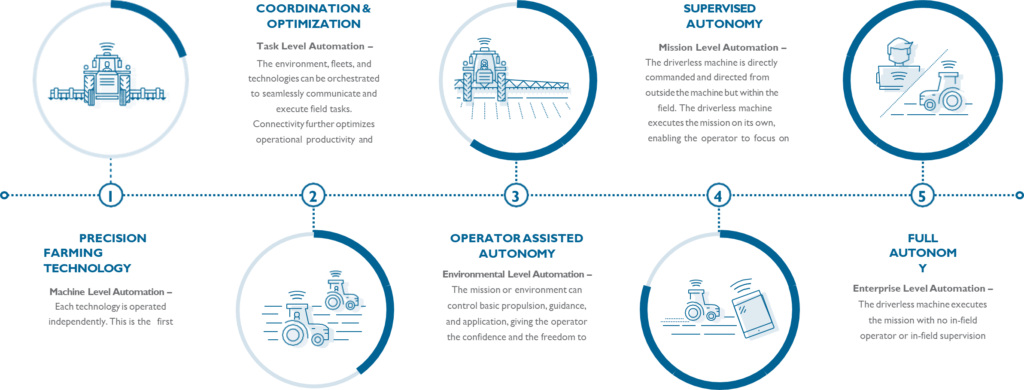Raven’s history
In post war times, a company called General Mills had several industries, including one for helium balloons. In the 1950s, four engineers purchased technology for the helium balloons from General Mills, before expanding into electronics, computers and software — the beginning of Raven Technologies. During the 1970s, they began working on farm equipment controls using basic electronics. They continued to evolve and by the 1990s, Raven was a leader in auto-steering technology for tractors guided by satellites.
Today, Raven leads the way in precision agriculture globally, being renowned for precision farming technology that outfits and enhances farm machines like sprayers and fertiliser spreaders. After supplying their control systems to Case New Holland (CNH) and other companies in recent years, they were eventually acquired by CNH in 2021.
The path to autonomy
Two decades ago, the concept of a self-driving tractor was considered unbelievable, almost like a myth. Today, full automation is a real possibility.
As the world’s population continues to grow and the demands of feeding them expand with it, farmers worldwide are turning to technology to become more efficient, productive and profitable. Raven Industries is dedicated to advancing farming through technology and innovation — and their director of sales, Ben Voss, gave us an exciting glimpse into agriculture’s path to autonomy.
How has the idea of autonomous technology evolved at Raven?
Raven Industries has a rich history in agriculture technology. They began in the 1970s, focusing on controlling sprayers and advanced into more electronic tools for tractors. By the mid-90s, they were a significant player in automatic steering and GPS-guided tractors. Their tech revolutionised precision farming, especially for sprayers and control equipment.
From the 1990s to the 2000s, they supplied specialised equipment for farm machines, such as product rate controllers for fertiliser spreaders and individual nozzle control for sprayers. In the last decade, there was a surge in technology development due to labour shortages in farming. The idea was to have advanced computer systems run the equipment autonomously, though farmers were initially sceptical because fields are full of unpredictable variables.
Between 2015 and 2020, Raven shifted its development focus to autonomy, acquiring smaller companies working on key autonomous tech. They acquired DOT, known for a driverless farm machine (rebranded as OMNiPOWER), and Smart Ag, with an “AutoCart” system (now called OMNiDRIVE®) that allows tractors to pull grain carts without drivers.
The combination of these technologies caught CNH’s attention, which led them to pursue the acquisition of Raven. This history and technological integration have been crucial in advancing agriculture technology
to where it stands today — and the future is full of possibilities as Raven integrates product and technology development processes with CNH’s leading farm machine platforms.
How is this technology changing farming?
To start, think of farming as an evolution. First, experienced farmers do everything themselves. Then, less experienced ones (or farmers becoming more efficient) use tech to help with tasks like managing application rates and turning equipment on and off. For example, the Case IH Patriot 50 Series sprayer can unfold its booms, spray each crop with precise coverage, and steer itself automatically using a vision- based unit that guides the machine around crop rows (VSN®). We are furthering spray automation with camera-based technology that automatically prescribes optimal variable rate application amounts based on what it detects to ensure each plant receives the individual treatment it needs, called Augmenta®. Automation essentially takes care of the tough tasks so the operator can focus on driving, reducing stress and improving efficiency.
The next level is operator-assisted autonomy, and this is what we are starting to make available to customers. Using these automation systems, the machine essentially functions automatically — all you need to do is basically drive it forward and stop in case of emergencies. For example, our Raven Cart Automation™ system synchronises a tractor and grain cart to the heading and speed of a harvester with the touch of a couple buttons — the operator only needs to pay attention to when the cart is full, then steer to disengage.
There is a lot of potential in this system — for instance, a corporate farmer in Australia might employ workers who lack farming equipment experience, but operator- assisted autonomy allows the farm manager to remotely monitor and instruct the operator in the tractor. The operator mainly handles emergencies and basic tasks and doesn’t require extensive farming knowledge.
Over time, as farms build communication systems and management infrastructure, they can gradually transition to full autonomy. However, becoming fully ready for autonomy requires thorough field mapping, understanding terrain features and having reliable systems in place.
The future-forward farmer takes that next step. Future farmers will base their decisions on numbers, considering labour, maintenance and resale value, and the goal is to make autonomy available as both a factory and retrofit option, meaning it can be added to existing equipment and removed, if necessary, which reduces risk.
What are the challenges with current technology?
Implementing comprehensive software systems for dealerships and farms is a complex task. Transitioning from manual record-keeping to digital systems takes time and effort. Many farms still lack standardised digital records, and competitors are working on comprehensive systems to support autonomy.
If a machine breaks down today, you might not know how to fix it. If there’s no cell signal, the machine can’t communicate — and this is one of the challenges we’re now facing. A solution might be something like Starlink (high-speed satellite internet) for constant info, but even if we can see how it would work, it takes time to make this a reality, and we’re working on that. We can upload instructions and software into machines to make them smarter, but the goal is for them to detect issues so that dealers like Ramsey Brothers could know about breakdowns. The idea is to be proactive, like having parts ready to go when needed.
What’s one of the biggest hurdles in making this a reality?
Making this tech a reality is exciting, but there are some important challenges. Take, for example, a combine harvester with around 23,000 parts. All these parts must be in a database and kept updated. Plus, there are different combine models and updates to consider, making it complex to cater for all farmers, past and future.
While start-up companies dream of disrupting the market with amazing innovations, the practical side is different, and we need to marry these things up. Australia has about 28,000 farmers. It’s about more than just cool tech — it’s also about getting farmers and dealerships on board so that the technical and execution components work cohesively.
Dealers play a crucial role, often acting as intermediaries between customers and tech providers, so we partner closely with them. They need to understand and manage the new technology — and training has evolved from simple tasks like changing oil to a comprehensive six-week course covering software, diagnostics and advanced tools. This is where CNH works closely with dealers like Ramsey Bros to make sure they’re equipped to help your customers use all this new technology and get the benefits.
What’s been the reception to all this new technology?
We often talk about this in terms of phases — where some pieces of the puzzle work for people before the whole thing is ready. Not everyone is equally excited about the latest advancements and some folks might be worried about how this tech changes their jobs and industries.
But the world is always changing, and this landscape is part of that. Interestingly, older farmers, who might seem resistant to new tech, are often the first to discuss it. They’ve been waiting for this, recognising the need for technology to sustain farming, given the declining workforce and the pandemic’s impact. And while automation might replace some jobs, it’s expected to create new ones in technology. Of course, that raises questions about finding these experts, especially in rural areas, but that’s all part of the industry’s evolution.
It’s a bit unprecedented trying to figure out exactly what the response is going to be, but technological progress has been remarkable. From typewriters and rotary dial phones with party lines, we now have powerful personal phones. While farming technology can be expensive, it brings indispensable benefits like auto- steering in tractors.
The pace of technological change is incredible, and we can’t imagine going back to the old ways.

Key to automation: What’s one ‘must-have’ product for today’s farmers?
One of Raven’s essential tools is Slingshot®, a software system that connects farm machines using cell networks. It lets machines like tractors or sprayers communicate, making them work together efficiently. For example, if there are two tractors planting seeds, Slingshot® ensures they don’t overlap, preventing resource wastage. It’s a crucial part of Raven’s expertise and complements our autonomy systems.
Farmers aiming for automation need tools like Slingshot® for communication, mapping software, and work order management. These help them manage their machines effectively — similar to how a service manager in a dealership creates work orders for mechanics, specifying what tasks need to be done.
Learn more at ravenind.com





